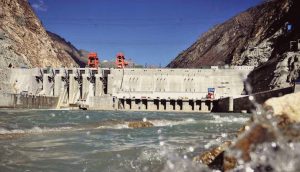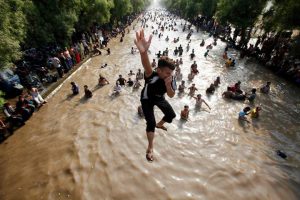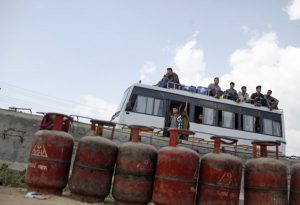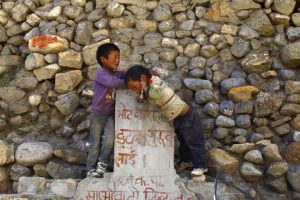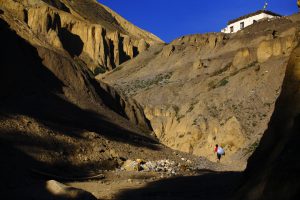According to the World Resources Institute approximately 5 million of the 21 million people affected by floods live in India. Even within India this flooding is unevenly distributed. The Indian National Remote Sensing Centre of the Indian Space Research Organisation states that, “the most flood-prone areas in India are the Brahmaputra, Ganga and Meghana River basins in the Indo-Gangetic-Brahmaputra plains in North and Northeast India, which carry 60% of the nation’s total river flow.”
Assam, the most populous north-eastern state experiences the brunt of this flooding. Almost 75% of the total Indian rainfall is concentrated over a short monsoon season of four months from June to September. Rivers swell enormously during this period, overflowing their banks.
Apart from monsoon rains, Assam is also fed by perennial rivers originating from the Himalayan ranges in in China and Bhutan and India’s Arunachal Pradesh state. Since the glacial melts coincide with the summer monsoon season, any intensification of the monsoon contributes to flood disasters downstream. Scientists from the Indian Institutes of Technology in Delhi and Guwahati have been part of government projects looking at the impact of climate change and flooding in Assam. Nevertheless the floods of 2015 were particularly devastating.
On 15 August 2011 when the rest of India was celebrating Independence Day, people in the Dhemaji district fled the floodwaters of the Gainadi river. A helpless administration could only watch as two women and a man clung to a tree in Tokobari village in a desperate attempt to save their lives. The SOS response came in late and more than 50 people were swept away by the flash flood including one on the tree. Tunu Duarah, a flood victim living in a make-shift shelter said, “We prepare for the floods even before the advent of spring. The three winter months bring a little respite”.
This September the Flood Forecast Monitoring Directorate of the Central Water Commission (CWC) warned that high to unprecedented flood were expected in the Brahmaputra basin in Dibrugarh, Dhemaji, Tinsukia and Lakhimpur districts of Assam, due to high water levels in rivers. This second bout of floods proved disastrous. Humans, farm animals and wildlife were washed away, millions of people were displaced and thousands of hectares of standing crops were destroyed.
According to the flood report released by the Assam Disaster Management Agency on 1 September 2015, about 144,000 hectares of land in almost 2,000 villages had been affected, with 875,000 people affected. Dhemaji District, which was most severely affected, with almost 350,000 people feeling the fury of the floods and more than 90,000 hectares of cropland flooded. Speaking to thethirdpole.net Robinson Kaman, the Dhemaji District Agriculture Officer estimated that as much as 3,700 hectares would have sandy silt deposited on them, affecting over 50,000 farm families. Having lost their agricultural land, house, cattle, kitchen gardens, woods and bamboo groves, some families have moved from Dhemaji some kilometres away and set up new habitation on higher ground, and are trying to eke out a livelihood through weaving on their looms.
The village of Digheri Mishing has embraced living on water. The village lies on both sides of the Jiadhol embankment. The houses are built on raised platforms held up by bamboo poles on both sides of the embankment. It is customary for the Mishing community to live in such houses locally known as chang ghars. The Mishings are basically river people. The river is their mother and they have grown up in her lap. Rather than leaving their traditional homes a handful of them are now fighting all odds. They have been living in a water world bereft of any basic amenities since 1983, dependent on their fishing nets for a livelihood. The embankment is the only ground that serves multiple purposes. From providing space to their pigs and a few poultry, it also serves as a burial ground at times.

Forced migration
The June 2012 flood in Assam was recorded as the worst since 2004. The Assam Disaster Management Authority put the figure of the total number of people evacuated during that time as 383,421 and the actual number of people found in government relief camps as 484,555. Oxfam India reports put the number of flood-affected in June-July, 2012 at 2.4 million while the number of displaced was half a million. Like the inhabitants of Digheri- Mishing village of Dhemaji who have no option but to live in water-logged conditions, many such affected families throughout the state are not recognised in official figures. Documentation of displacement is very important for policy formulation.
The floods this September affected 1.7 million people in Assam. Twenty districts of the state were severely affected and as many as 226,280 flood-hit people took shelter in 294 relief camps set up by the authorities, according to the official flood bulletin of the Assam State Disaster Management Authority in early September.
The challenge
After the floods, displaced people end up in make-shift camps that are always inadequate to cater to the needs of such a large number of flood-affected families. This is the usual story during floods. The large number of people, including children, women and elderly who endure a nightmarish existence in the ill-equipped shelters every year, shows the lack of disaster preparedness and response in the state. Some people move on to city slums or to become encroachers on forest lands taking up illegal activities like logging. Families that try to settle on government lands face eviction again and again.
With the number of displaced people growing there is a drop in the percentage children going to school. The social life of people is disrupted due to their displacement. Bijon Sarma, office bearer of the Dhemaji Press Club lamented that thousands of young people from the flood-affected families of the district abandoned their studies to find a job in hotels, spas, or work as security guards in the metros of cities like Mumbai, Pune, Delhi, Hyderabad, Tiruvanathapuram or Bangalore.
Child trafficking
More tragically children and young women fall victim to the scourge of human trafficking. Assam’s perennial flood problem has made the state a source state for child trafficking. Nobel laureate and child rights crusader Kailash Satyarthi pointed out that Assam has been a major source for child trafficking owing to the state’s huge flood displaced population. These children, the Nobel laureate lamented, finally disappear in big cities as workers in small-scale garment industries or hired as domestic workers. The crime investigation branch of Assam police records list Lakhimpur and Dhemaji districts among the most vulnerable districts to the growing menace of trafficking. With no adaptive mechanisms in place, the impact of climate change compounds disaster upon disaster for the people of Assam.
![<p>Children in Assam’s flooded landscape [image by Mubina Akhtar]</p>](https://dialogue.earth/content/uploads/2015/10/Assam-floods-ii.jpg)
